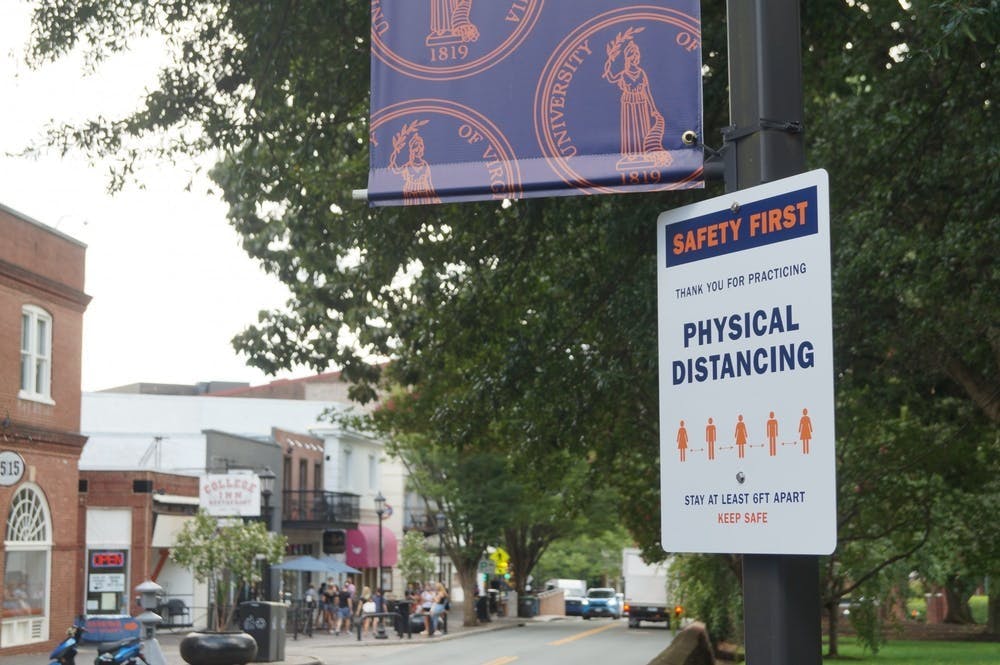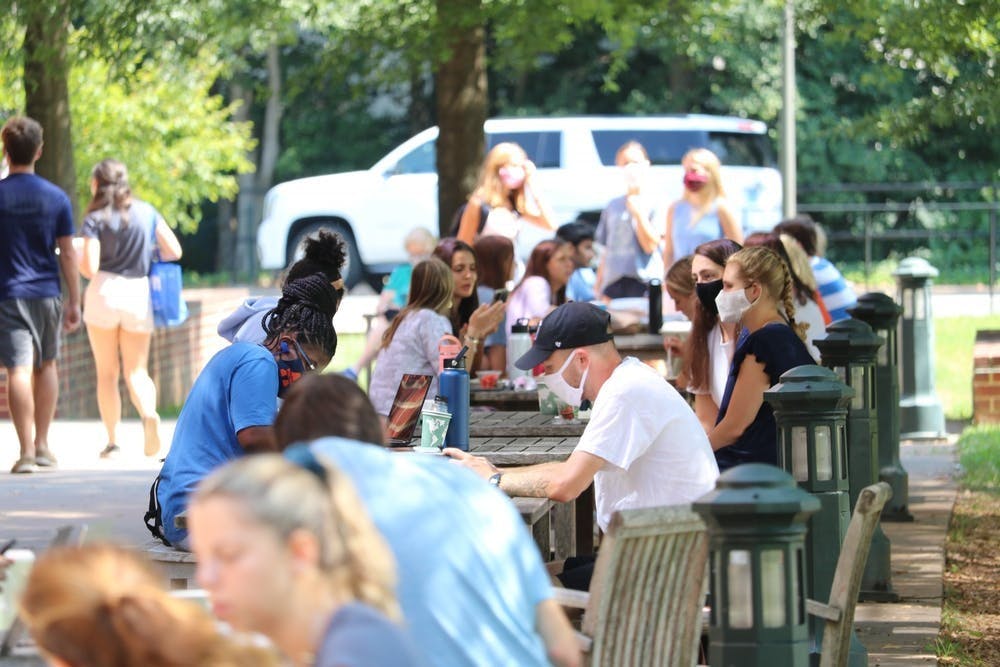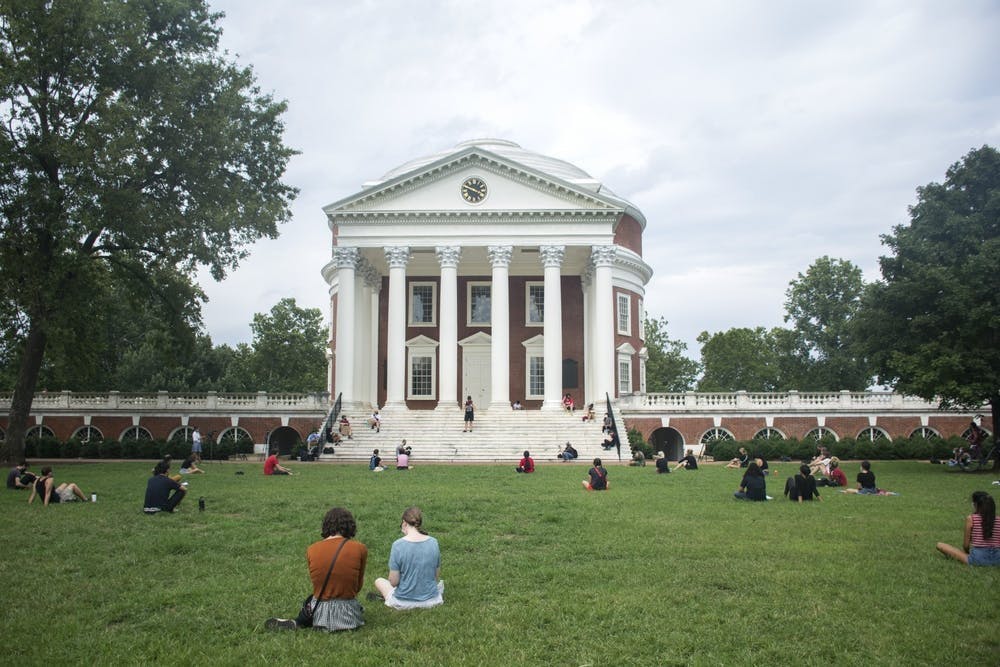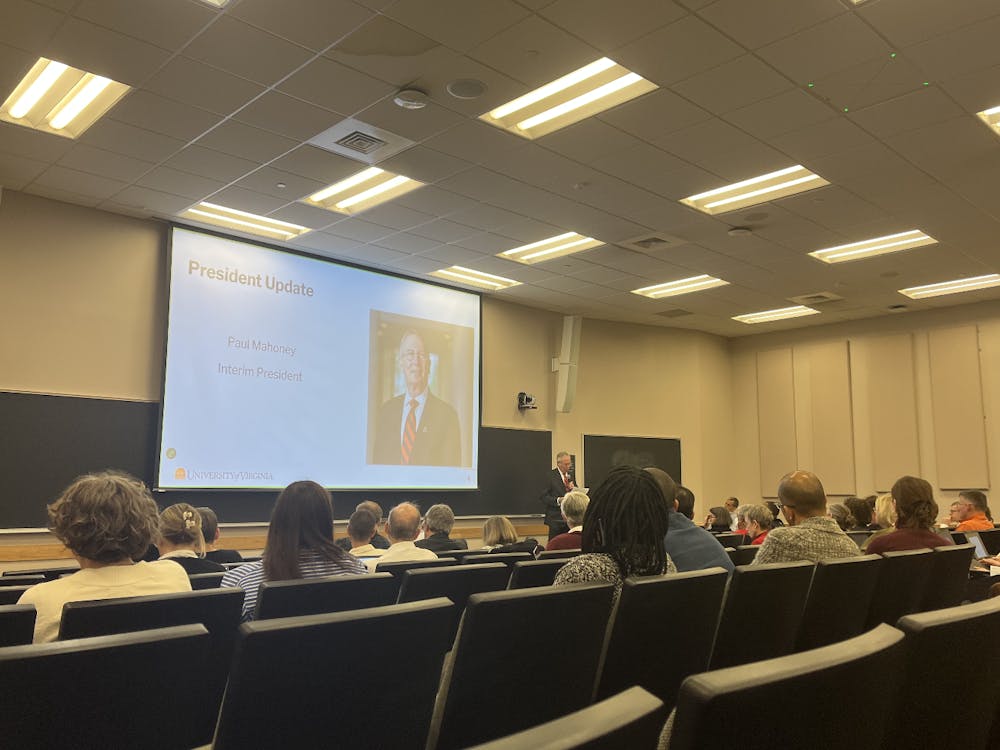When the University reopened its doors in early September amid the ongoing pandemic, many wondered how its testing and housing capacity would fare in comparison to other colleges that were forced to quickly send students home due to growing COVID-19 cases.
Just weeks after reopening, the University found itself following a similar fate with rising case counts and an anxious student body — but the situation changed mid-semester with the implementation of new testing protocols. The University went from testing under 2,000 students weekly at the beginning of the semester to thousands of students daily, yielding 1,346 total positive cases among students, faculty, staff and contracted employees since Aug. 17.
Wes Hester, deputy spokesperson and director of media relations for the University, said the progress made this semester has been encouraging — but there were also challenging moments along the way.
With the fall semester ending this week, The Cavalier Daily looks back at the University’s testing and caseload information.
Early semester

Photo by Sophie Roehse
The University’s efforts to test students began with the distribution of tests from COVID-19 testing provider LetsGetChecked throughout August. In order to return to Charlottesville or live in on-Grounds housing, the University mandated that students take a self-administered COVID-19 test.

Photo by Nik Popli
“Tackling COVID-19 is a challenge, but we will have a successful return to Grounds if we pull together and take the individual steps necessary to keep ourselves and the people around us safe,” said Provost Liz Magill and Chief Operating Officer J.J. Davis when announcing the testing policy to the community.
The vast majority of the tests given out to students before the start of the semester came back negative, with 36 out of more than 12,000 tests returning a positive result.
Cases soon began to increase in the University community despite the University’s efforts to institute entry testing. By Aug. 28, just three days after the fall semester had begun fully-online, the number of cases in the University community had climbed to a daily high of 23, up from just three cases on Aug. 21.
In the face of a rising caseload, the University opted to allow first-year students to live on Grounds and to resume some in-person instruction Sept. 8. Seeing how other schools like the University of North Carolina at Chapel Hill had several COVID-19 clusters within student housing, the University made the decision to relocate hundreds of students to other dorms prior to their return to Grounds to make space for quarantine and isolation rooms. The University allocated approximately 1,500 quarantine and isolation beds.
Days before in-person classes were set to begin, numerous students reported difficulties getting COVID-19 tests from the University despite being symptomatic or close contacts of those with symptoms.
Third-year College student Joelle Miller was unable to get a test from the University after calling the Student Health center, despite the fact that her friend — who Miller had recently been in contact with — had been in contact with a person who had tested positive for the virus.
Miller had presumed that she could receive an asymptomatic test from the University, as a message sent to students July 16 stated the University’s intention for students to receive one asymptomatic test every 60 days. However, according to Hester, the LetsGetChecked pre-arrival testing counted as one of the asymptomatic tests provided to students.
Around the same time as students expressed difficulties getting tested, the University announced plans to begin a saliva testing program to measure virus prevalence in the community — a project that has grown over the course of the semester. The program, which was intended to begin during the second week of September, was implemented during the first week of October and tested 557 students within seven days.
“U.Va. has significantly increased its asymptomatic testing using nasal swab tests and saliva tests, and complemented its testing with a wastewater analysis program that has provided an early warning of the presence of the virus that causes COVID-19 in residence halls,” Hester said.
In an interview during the first week of October, Hester stated that the University hoped it would be able to test all students weekly by the end of the semester.
An outbreak emerges

Photo by Ankit Agrawal
From late August to early September, it was clear that the University’s caseload was beginning to increase. On a week-to-week basis, the number of cases continued to grow without signs of slowing.
On Sept. 10, two days after the University had begun in-person classes, U.Va.’s COVID-19 numbers hit a new peak — 39 positives in one day. The University’s quarantine and isolation beds also began to start filling up, with eight percent of quarantine beds occupied.
The number of daily positives hit their peak Sept. 17, nearly two weeks after first-year students moved into their dorms. Newly reported cases hit a high of 59, of which 57 positives came from students.
Another form of testing — screening the wastewater of U.Va.’s dorms for COVID-19 — led to the discovery of potential outbreaks in at least five first-year residence halls — Balz-Dobie, Lefevre, Echols, Kellogg and Hancock.
“In our residence halls, the [testing] program has enabled us to quarantine and isolate students who test positive but are not showing symptoms and to institute contact tracing to further address potential spread,” Hester said.

Courtesy Lisa Colosi-Peterson
The University reported 195 cases of COVID-19 in on-Grounds housing in September, 110 cases in October and at least 11 cases in November, according to the most recent data available. There were at least 316 cases related to on-Grounds housing this semester — less than one third of the University’s 1,081 total cases among students — suggesting that the majority of outbreaks occurred off Grounds.
University President Jim Ryan announced Sept. 22 that the University would be making additional efforts to curb the spread of COVID-19 in the University community with several new restrictions, including increased mask requirements, stricter group limits and less travel outside Charlottesville. As part of the restrictions, students could not gather in groups of more than five people — a reduction from the fifteen-person gathering limit mandated at the beginning of the semester.
At the time of Ryan’s announcement, there were more than 224 active cases of COVID-19 in the University community. Two days later, the number of active cases had risen to 238 and the number of quarantine rooms occupied had risen to 28 percent. The positivity rate among students also reached 9.17 percent.
While the restrictions prevented another peak, case numbers were slow to go down. The seven-day moving average for positive test results remained above 20 from Sept. 16 to Oct. 6, resulting in the University extending its enhanced restrictions Oct. 6 for an additional two weeks.
However, by Oct. 13, the University felt comfortable increasing the permitted gathering size to ten, citing increased testing efforts. The gathering restriction remained at ten for the rest of the semester. Additionally, on-Grounds students would now have to report for testing every nine days, and the University increased its efforts in prevalence testing.
Following the increased restrictions, the number of positive tests dropped, even as the University’s testing capacity markedly increased. By Nov. 1, the seven-day moving average for positive test results had dropped down to 3.43 — the lowest number the University has recorded since it began keeping track Aug. 17.
Testing increases

Photo by Leigh Bierman
Over the course of the semester, the University has seen a significant increase in its testing capacity. More than two months ago, during the week of Sept. 6 to Sept. 12, the University conducted 1,630 tests. Approximately one month ago, during the weeklong period of Oct. 11 to Oct. 17, the University conducted 4,274 tests. From Nov. 1 to Nov. 7, 6,427 tests were administered by the University and tests increased again to 8,655 between Nov. 8 and Nov. 14.
During the three-month period from Aug. 17 to Nov. 16, the University administered more than 40,000 coronavirus tests for full-time, professional and part-time students — not including pre-arrival testing.
Of those tests, more than 20,000 have been saliva tests since Oct. 1. On Nov. 17, the University’s saliva prevalence testing yielded 1,622 negative results and 3 positive results.
Saliva screenings have an 85 percent sensitivity rate, meaning that if 100 people positive for COVID-19 take the test, it will only detect 85 of those cases.
Despite the increase in testing, the average time to analyze a test is currently under 24 hours.

Photo by Ava Proehl
As students return home for Thanksgiving break and final exams, the University is offering off-Grounds students an additional test to reduce the spread of COVID-19 in their home communities.
The University also announced that given the increase in cases in the region and across the country, the University will mandate weekly testing for students remaining in the Charlottesville/Albemarle area between Nov. 30 and Dec. 18.
“In order to make it as convenient as possible for you to comply with this testing requirement, testing will be available on a walk-in basis on weekdays and Sunday afternoons at the Central Grounds Parking Garage,” wrote Magill, Davis and Department of Medicine Chair Dr. Mitch Rosner.
Additionally, the University is once again requiring students to submit a negative COVID-19 test from LetsGetChecked before returning in the spring. The University will also continue the same testing efforts used this semester, including wastewater and saliva testing.
“During the [spring] semester, U.Va. will continue its prevalence testing programs, with all students being tested at least once every nine days during the semester,” Hester said.
As cases have risen to new highs nationally, including in Virginia, the University is confident that its testing program is strong.
“Combined with preventive measures including mask-wearing, regular hand-washing and avoiding large gatherings, U.Va.’s testing program has placed the University in a strong position for the home stretch of the semester – even as cases of the coronavirus are surging across the country,” Hester said.
However, according to Rosner, it is important to remember that testing is not a silver bullet to preventing incidences of COVID-19 in the University community as no test is 100 percent sensitive.







